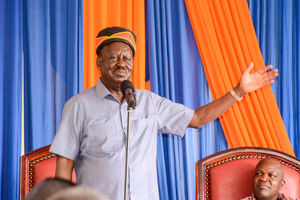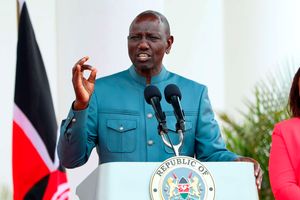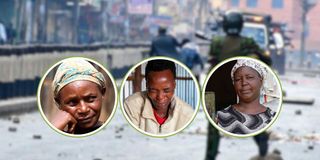
From left: Agatha Kiragu, Rachael Nyambura and Jecintah Gathoni Ngugi, who lost their sons during the anti-government protests on June 25, 2025.
When she sent her firstborn son David Kariuki, 19, to pick up her last-born aged seven from a tuition school in the Maziwa area of Imara Daima on Wednesday, Rachel Nyambura did not know it would be the last time she would see him alive.
Her dutiful son, who always helped her in her food vending business, never talked back when given instructions.
As soon as she told him to fetch his younger sibling, Kariuki quietly put on his shoes and left.
Instead of returning with his brother, Kariuki became the victim of a fatal bullet allegedly fired by a senior officer from the nearby Villa Police Station.
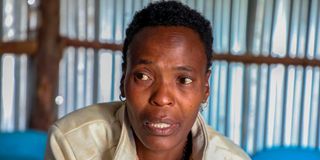
Rachael Nyambura at her house in Mukuru Kwa Njenga Nairobi on June 26, 2025. Her son David Mwangi 19 was allegedly shot dead by police during the anti-government protests on June 25, 2025.
The bullet struck him squarely on the forehead, killing him instantly.
Just like that, Kariuki who was set to join Dykaan College along Outer Ring Road to pursue a course in mechanics became another statistic, one of the many who died at the hands of state security agencies during Wednesday’s commemoration of the June 25, 2024, Anti-Finance Bill protests.
Seated in her home in Mukuru Kwa Njenga, Ms Nyambura could not hide her pain as she recounted the ordeal.
Tensions had been high in the informal settlement with teargas and running battles between locals and the police. This, she said, was what prompted her to send Kariuki to get his brother.
However, when the seven-year-old returned home alone at around 3pm, she thought little of it.
The only thing that raised concern was that Kariuki who normally collected goods for her food vending business at 3pm had not yet done so.
Unfazed, she decided to collect the goods herself. On her way back, she received a phone call from a local youth informing her that her son had been shot dead and his body was lying at Villa Police Station.
“My heart stopped. I dropped everything and rushed to the station with the youth. The police lied to me, claiming my son was at Mukuru Community Health Centre but when I got there, he wasn’t. I rushed back to the station where they blocked me from seeing his body,” she said.
This back and forth triggered a confrontation with the police as the youth and Ms Nyambura’s brothers demanded access to the body. By then, it was nearly 7pm and tensions flared.
Enraged, the youth set two vehicles at the station ablaze while demanding Kariuki’s body. The chaos continued until midnight when the police finally allowed the family to access it.
“The officers ignored us and began writing a statement without involving us or the witnesses. That’s when we pulled Kariuki’s body from the police Land Rover and insisted the statement would not continue unless we were consulted,” said John Mwangi, Ms Nyambura’s brother.
However according to the family, the police version of events did not add up.
According to them, officers claimed Kariuki died during the chaos at the station around 7pm when protesters set the vehicles ablaze.
But metadata from a photo taken on Mr Mwangi’s phone at the scene showed that Kariuki died around 4pm long before the station fracas.
Kariuki’s case is not isolated.
Fighting for his life
In Ol Kalou Town in Nyandarua County, Ndung'u Gichuki, 19, was shot dead by a police officer during Wednesday’s protests.
“His friends say he was unarmed. He was only carrying the Kenyan flag. Is it a crime for a young man to protest with a flag? We demand justice. We want to know who killed him and why,” said his aunt, Jane Njeri.
Gichuki, a jovial aspiring journalist, had been saving money from his photography business to enroll in journalism school. He lived in a small rented room in the Mirangine area.
Meanwhile, in Kitale Town, Abraham Masinde, 17, a Form Three student at Lessos Secondary School is fighting for his life after being shot by police in Matisi slums. He was caught in the melee between protesters and police.
In Eldoret, more than 70 suspects were arrested during the Gen Z demonstrations. Uasin Gishu County Police Commander Benjamin Mwanthi said they would be arraigned on Friday.
“We have arrested 72 people suspected of engaging in various criminal activities during the protests. One person was killed by members of the public on suspicion of masquerading as a demonstrator to cause mayhem in the town,” Mr Mwanthi said.
In Nyeri, four people were killed while 27 others including a police officer were injured during Wednesday’s Gen Z protests.
Two of the victims were shot dead in Karatina Town, one in Nyeri Town, and the fourth in Othaya Township.
According to Nyeri County Commissioner Ronald Mwiwawi, 12 of the injured are nursing gunshot wounds and are admitted to various hospitals across the country.
However, 15 others were treated and discharged following the protests, which saw businesses looted as demonstrators engaged police in day-long running battles.
In Othaya, just half an hour after leaving his home in Kihuguru village to join the anti-government protests, 27-year-old Joseph Ndonga was declared dead. Ndonga had arrived in town around 5pm expecting that the day-long demonstrations had subsided.
According to his mother Agatha Kiragu, her son had only briefly stopped by the house after returning from his casual job at a nearby construction site.

Agatha Kiragu during an interview at her home in Kihugiru village, Nyeri County, on June 26, 2025. Her son, Joseph Ndonga, was allegedly shot by police in Othaya town during the anti-government protests.
“He came home, bathed and quickly left for town. He was curious to see what was happening since things had suddenly gone quiet,” she said.
Eyewitnesses said that at the time of the shooting, Ndonga was standing away from the main crowd of protesters, occupied with his phone. A police officer, whom locals claim appeared to take deliberate aim, reportedly knelt and fired at Ndonga — hitting him in the right hand, with the bullet exiting through his chest. At the time, protesters and police were engaged in running battles.
Residents said the protesters, who had by then been infiltrated by goons, were targeting the police canteen at Othaya Police Station. Two vehicles had earlier been burnt at the Deputy County Commissioner’s office. Four other protesters were injured in the chaos and were rushed to Mwai Kibaki Level Six Hospital.
In a separate incident in Nyeri Town, another protester was shot by a plainclothes police officer while attempting to access Naivas Supermarket.
In Karatina, two people died, 14 police officers — including their commander — were injured, and 18 civilians were also wounded.
One of the victims was identified as Kevin Ouma, a gym attendant in Karatina Town. The other was a young man with no identification documents. Both were shot by police bullets during the running battles.
Kevin was allegedly hit by a “stray” bullet while on the fourth floor of a building where the gym is located. At the time, he was said to have been observing the chaos unfolding on the street below.
Demonstration turned violent
The second victim was reportedly shot by a plainclothes officer at a cemetery yard where he had gone to hide to avoid confrontation with anti-riot police.
Mathira East Sub-County Police Commander Samson Leweri who is also nursing injuries, confirmed the two fatalities but was non-committal on who shot the victims, saying the matter is under investigation.
“It is very unfortunate that what was supposed to be a peaceful demonstration turned violent. We are investigating what happened. Our officers tried to restrain themselves despite the provocation, which resulted in many of them being injured,” he said.
Mr Leweri sustained serious hand and leg injuries after being pelted with stones. He was treated at a local hospital and discharged, along with 13 other officers, including a deputy OCS.
At least 18 people, some with bullet wounds, were treated at Karatina Level Four Hospital and later discharged.
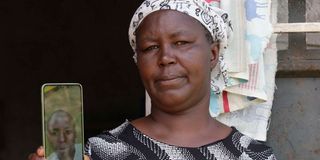
Ms Jecintah Gathoni Ngugi, displays the picture of her 17-year-old son Dennis Njuguna Ngugi, who was allegedly shot dead by the police during protests along Molo- Elburgon road near Molo Town on June 25, 2025.
One of the injured victims was reportedly shot in the leg by police as hundreds of demonstrators unsuccessfully attempted to invade the rural home of Mathira MP Eric Wamumbi in Kamunyaka village, about five kilometres from Karatina Town. There, they clashed with hired goons and some police officers in a one-hour confrontation before retreating.
Dr Amakove Wala, who coordinated first responders during the protests, said her team handled around 500 casualties.
“We referred 89 people to Kenyatta National Hospital. Of those, eight had live bullet wounds. The rest suffered injuries from rubber bullets or bruises,” Dr Wala said by phone.
“We treated three unconscious pregnant women, one child injured by a teargas canister, and even three police officers. Two officers were transferred to KNH. Two of my team members were also injured—hit by teargas and sprayed with water cannons.”
Deputy President Prof Kithure Kindiki condemned the loss of lives, destruction of public and private property, wanton looting and destruction of private businesses terming it “unprecedented”.
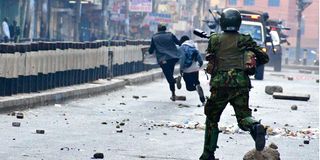
Protestors run for safety as anti-riot police close in on them on Ronald Ngala Street in during the anti-government protest on June 25, 2025.
“On behalf of President William Ruto, I want to assure that we will not allow ever again what happened yesterday to be repeated. We cannot allow our country to slide into anarchy, lawlessness, and chaos. We will do whatever it takes to protect our country from sliding into anarchy. What happened yesterday is a turning point in our country,” he said.
Opposition leaders called for accountability to heal the growing rift between the state and its youthful population.
Their appeal came a day after the chaotic anniversary of the June 25, 2024 protests that originally left 60 people dead.
Wiper leader Kalonzo Musyoka, former Interior CS Fred Matiang’i, and DAP-K party leader Eugene Wamalwa said the government must accept that there is a problem and initiate an open national conversation.
“If we want to move forward, we must speak the truth. Let’s be open,” said Mr Matiang’i.
“This is not the country we hoped for. We must continue calling out police brutality. The nation is united in its fury against an uncaring administration,” he said.
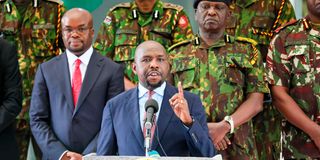
Interior Cabinet Secretary Kipchumba Murkomen, flanked by senior government security officials, addresses the media at Harambee House in Nairobi on June 26, 2025.
On Thursday, Interior Cabinet Kipchumba Murkomen said more than 10 Kenyans had been killed in the protests. Amnesty International in a statement it had documented the deaths of 16 Kenyans.
Eight of the deaths were confirmed in six counties: two each in Machakos and Makueni, and one each in Kiambu, Nakuru, and Nyandarua.
Democracy for the Citizens Party leader Rigathi Gachagua condemned the manner in which the government responded to Wednesday's Gen Z commemorative protests, accusing the regime of orchestrating violence and targeting peaceful demonstrators.
He also accused the government of media suppression.
After visiting victims at Kenyatta National Hospital, Mr Wamalwa said, “We’ve seen people here nursing bullet wounds. Wednesday was supposed to be a day of remembrance—not another day of mourning.”
“This is adding salt to injury,” he said, warning the government against normalising political violence and goonism. “It’s like riding the back of a tiger.”
Kisii Senator Richard Onyonka urged the state to pursue justice for all those affected.
“If there’s no justice, there will never be peace,” he said.
Reporting by Steve Otieno, Daniel Ogetta, Stephen Munyiri, Mercy Mwende, Waikwa Maina, John Njoroge, Evans Jaola and Titus Ominde



